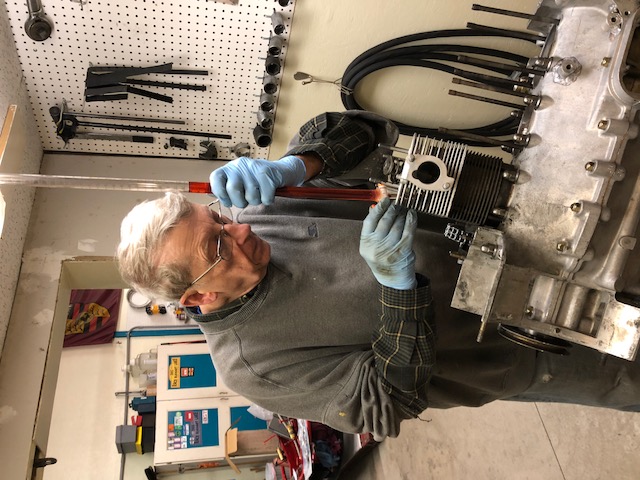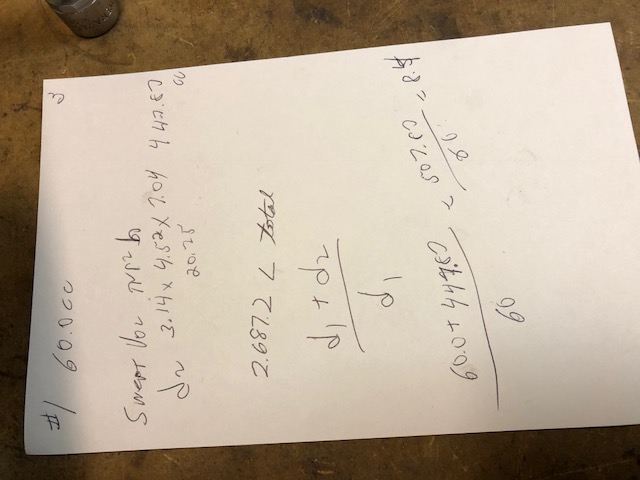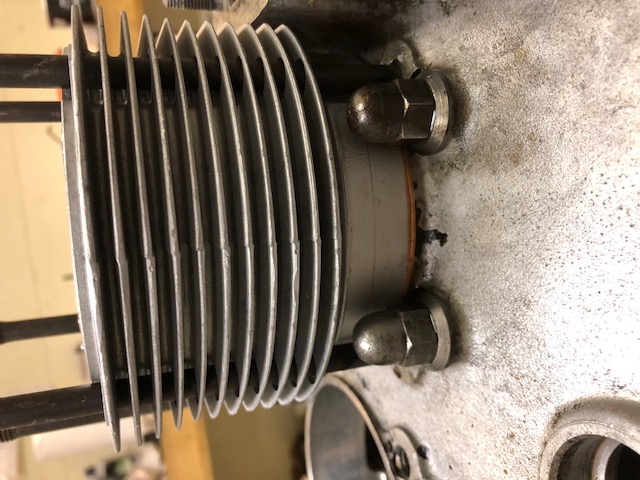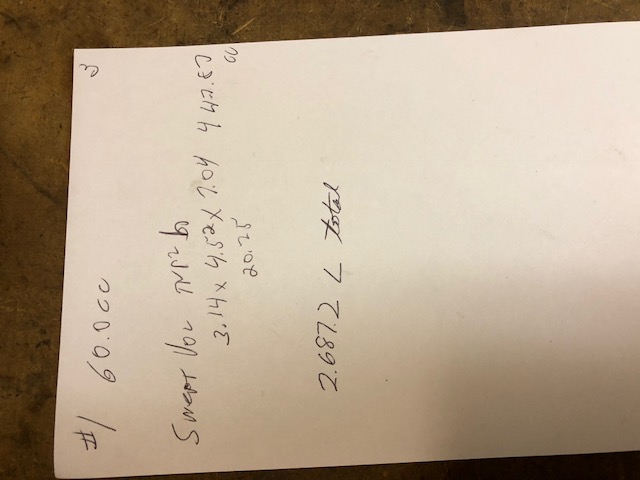|
|

|
Porsche, and the Porsche crest are registered trademarks of Dr. Ing. h.c. F. Porsche AG.
This site is not affiliated with Porsche in any way. Its only purpose is to provide an online forum for car enthusiasts. All other trademarks are property of their respective owners. |
|
|
  |
| Tdskip |
 Mar 25 2020, 07:17 AM Mar 25 2020, 07:17 AM
Post
#1
|
|
Advanced Member     Group: Members Posts: 3,686 Joined: 1-December 17 From: soCal Member No.: 21,666 Region Association: None 
|
Compression Ratio Maybe someone has done this before but I searched and didn't find anything. I decided to omit my head gaskets while my engine was apart but was worried that it might raise compression ratio (CR) too much. So I needed to make a comparison of compression ratio with head gaskets and without. These are the tools I used. In the picture is.. 1. Straight edge (blue-point tool made for checking flat surfaces. 2. Plexiglas disk link type 4 store 3. Syringe with CC gradients 4. Digital Caliper 5. Feeler gauge 6. Short and long spacers that I made to hold down the cylinder (optional) ------------------------------------------------------------------------ First You’ll need to measure Head Chamber Volume. Lay the head on a flat surface. The rockers/valve springs make it uneven so I used 2x4’s on the valve cover surface to make the head sit flat. Put the Plexiglas disk on the sealing surface of the head and measure the amount of fluid it takes to fill the chamber. I used ATF. My Head Chamber Volume was 60cc. ------------------------------------------------------------------------ Second You’ll need to measure Piston Dish Volume, or the size of the valve pockets in the piston using the Plexiglas disk again. Mine measured 4cc. If you have flat pistons skip this, your Piston Dish Volume is zero. If you have domed pistons you’ll need to fill a container with fluid and measure the amount the dome displaces and use a negative number as the Piston Dish Volume. ------------------------------------------------------------------------ Third You’ll need to measure Deck Height. You’ll need to “mock up” the engine with at least one cylinder and piston. I reused the original cylinder shim for the mock up but you could just add the thickness of the shim to the deck height. If for some reason you were going to use head gaskets you would add their thickness to the deck height as well. I tried two different ways to compare which was more accurate. Both ways were close enough that I think either way is acceptable. My deck height was .040 inch. Deck Height with feeler gauge (easier) Deck Height with Digital Caliper (Looks flashy with fancy tool but don’t forget to subtract out the thickness of your straight edge) Now for the math... ------------------------------------------------------------------------ Calculate Volume of one cylinder = Displacement / 4 My engine example… My 2.0 liter is actually 1971cc. 1971cc / 4 = 492.75cc ------------------------------------------------------------------------ Convert Deck Height (inch) to Deck Volume (cc) with this formula Bore (mm) x Bore (mm) x Deck Height (in.) x .01996 = Deck Volume (cc) My engine example… 94 mm x 94 mm x .040 inch x .01996 = 7.0546624 Deck Volume (cc) (round to 7cc) ------------------------------------------------------------------------ Calculate Combustion Chamber Volume Head Volume + Piston Volume + Deck Volume = Combustion Chamber Volume My engine example… 60cc + 4cc + 7cc = 71cc Combustion Chamber Volume ------------------------------------------------------------------------ Calculate Compression Ratio with this formula (Combustion Chamber Volume + one cylinder volume) / Combustion Chamber Volume =Compression Ratio My engine example… (71cc + 492.75cc) / 71cc = 7.9 Compression Ratio ------------------------------------------------------------------------ I think I can live with 7.9 but how does this compare with the compression ratio with the head gaskets? Most numbers are the same except I’ll need to add the thickness of the head gasket to the Deck Height. My head gaskets were .030 inch making Deck Height .070 inch. So… Deck Volume 94 mm x 94 mm x .070 inch x .01996 = 12.3456592 Deck Volume (cc) (round to 12cc) Combustion Chamber Volume 60cc + 4cc + 12cc = 76cc Combustion Chamber Volume Compression Ratio (76cc + 492.75cc) / 76cc = 7.4 Compression Ratio I think I can live with the 7.9 CR. Maybe I can gain a little power without too much additional heat?? Maybe use this link if you don’t like math. http://www.race-cars.net/calculators/compr...calculator.html Need to figure out what the mystery engine was running... Shout out to @CoolAirVw if you are still here. |
| porschetub |
 Mar 25 2020, 01:41 PM Mar 25 2020, 01:41 PM
Post
#2
|
|
Advanced Member     Group: Members Posts: 4,697 Joined: 25-July 15 From: New Zealand Member No.: 18,995 Region Association: None |
Compression Ratio Maybe someone has done this before but I searched and didn't find anything. I decided to omit my head gaskets while my engine was apart but was worried that it might raise compression ratio (CR) too much. So I needed to make a comparison of compression ratio with head gaskets and without. These are the tools I used. In the picture is.. 1. Straight edge (blue-point tool made for checking flat surfaces. 2. Plexiglas disk link type 4 store 3. Syringe with CC gradients 4. Digital Caliper 5. Feeler gauge 6. Short and long spacers that I made to hold down the cylinder (optional) ------------------------------------------------------------------------ First You’ll need to measure Head Chamber Volume. Lay the head on a flat surface. The rockers/valve springs make it uneven so I used 2x4’s on the valve cover surface to make the head sit flat. Put the Plexiglas disk on the sealing surface of the head and measure the amount of fluid it takes to fill the chamber. I used ATF. My Head Chamber Volume was 60cc. ------------------------------------------------------------------------ Second You’ll need to measure Piston Dish Volume, or the size of the valve pockets in the piston using the Plexiglas disk again. Mine measured 4cc. If you have flat pistons skip this, your Piston Dish Volume is zero. If you have domed pistons you’ll need to fill a container with fluid and measure the amount the dome displaces and use a negative number as the Piston Dish Volume. ------------------------------------------------------------------------ Third You’ll need to measure Deck Height. You’ll need to “mock up” the engine with at least one cylinder and piston. I reused the original cylinder shim for the mock up but you could just add the thickness of the shim to the deck height. If for some reason you were going to use head gaskets you would add their thickness to the deck height as well. I tried two different ways to compare which was more accurate. Both ways were close enough that I think either way is acceptable. My deck height was .040 inch. Deck Height with feeler gauge (easier) Deck Height with Digital Caliper (Looks flashy with fancy tool but don’t forget to subtract out the thickness of your straight edge) Now for the math... ------------------------------------------------------------------------ Calculate Volume of one cylinder = Displacement / 4 My engine example… My 2.0 liter is actually 1971cc. 1971cc / 4 = 492.75cc ------------------------------------------------------------------------ Convert Deck Height (inch) to Deck Volume (cc) with this formula Bore (mm) x Bore (mm) x Deck Height (in.) x .01996 = Deck Volume (cc) My engine example… 94 mm x 94 mm x .040 inch x .01996 = 7.0546624 Deck Volume (cc) (round to 7cc) ------------------------------------------------------------------------ Calculate Combustion Chamber Volume Head Volume + Piston Volume + Deck Volume = Combustion Chamber Volume My engine example… 60cc + 4cc + 7cc = 71cc Combustion Chamber Volume ------------------------------------------------------------------------ Calculate Compression Ratio with this formula (Combustion Chamber Volume + one cylinder volume) / Combustion Chamber Volume =Compression Ratio My engine example… (71cc + 492.75cc) / 71cc = 7.9 Compression Ratio ------------------------------------------------------------------------ I think I can live with 7.9 but how does this compare with the compression ratio with the head gaskets? Most numbers are the same except I’ll need to add the thickness of the head gasket to the Deck Height. My head gaskets were .030 inch making Deck Height .070 inch. So… Deck Volume 94 mm x 94 mm x .070 inch x .01996 = 12.3456592 Deck Volume (cc) (round to 12cc) Combustion Chamber Volume 60cc + 4cc + 12cc = 76cc Combustion Chamber Volume Compression Ratio (76cc + 492.75cc) / 76cc = 7.4 Compression Ratio I think I can live with the 7.9 CR. Maybe I can gain a little power without too much additional heat?? Maybe use this link if you don’t like math. http://www.race-cars.net/calculators/compr...calculator.html Need to figure out what the mystery engine was running... Shout out to @CoolAirVw if you are still here. I used a piece of 12mm key steel clamped across the top of the barrel with my hold down spacers,getting the true deck height volume was a little tricky as I was using euro high top 411 NOS pistons. I managed to find info on the Samba.com which stated the volume of the raised dome was 4cc if I remember correctly,I then downloaded the CB performance calculator and after adding shims and measuring head volume I was on target with 8.6-1 compression with just over 1mm clearance. IMO it is important to check and recheck again to get consistent results. |
| jfort |
 Mar 25 2020, 04:23 PM Mar 25 2020, 04:23 PM
Post
#3
|
|
Senior Member    Group: Members Posts: 1,135 Joined: 5-May 03 From: Findlay, OH Member No.: 652 Region Association: Upper MidWest 
|
I have helped Jay Kjoller do this a few times. He mades up one cylinder and puts the spark plug hole at the top. Using liquid, he measures the volume to the top of the head, subtracts spark plug hole V (2.2 cc) and thereby calculates combustion chamber V notwithstanding the crazy shapes of the piston and head. You know what the bore and stroke are. The ratio is, well ... the ratio. If you can get the attached calculations to open, you can see what adding shims did. Old pistons were 8.5. New JE pistons, with shims/spacers, came out, finally, to 10.8, which Jay's experience confirms as close.
  compression_ratio_calculations__dragged_.pdf ( 265.79k )
Number of downloads: 73
compression_ratio_calculations__dragged_.pdf ( 265.79k )
Number of downloads: 73 compression_ratio_calculations__dragged_.pdf ( 207.95k )
Number of downloads: 72
compression_ratio_calculations__dragged_.pdf ( 207.95k )
Number of downloads: 72  Attached image(s) 
|
| Tdskip |
 Mar 25 2020, 04:26 PM Mar 25 2020, 04:26 PM
Post
#4
|
|
Advanced Member     Group: Members Posts: 3,686 Joined: 1-December 17 From: soCal Member No.: 21,666 Region Association: None 
|
Super helpful
I don’t know the stroke yet but I do know the bore. Appreciate the follow up and technical information. I have to say it is quite exciting to be learning all of this via World’s coaching. Thank you gentlemen. |
| CoolAirVw |
 Apr 3 2020, 10:27 PM Apr 3 2020, 10:27 PM
Post
#5
|
|
Member   Group: Members Posts: 66 Joined: 4-July 06 From: Kansas City Area Missouri Member No.: 6,370 |
I still own my 2nd 914 but it just sits. I rarely look at this forum, but I had a customer come through my shop with a sweet little green 914.
Here is the link to the compression ratio thread. http://www.914world.com/bbs2/index.php?showtopic=64588 |
  |
1 User(s) are reading this topic (1 Guests and 0 Anonymous Users)
0 Members:

|
Lo-Fi Version | Time is now: 7th May 2024 - 09:28 AM |
Invision Power Board
v9.1.4 © 2024 IPS, Inc.








